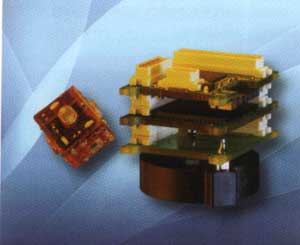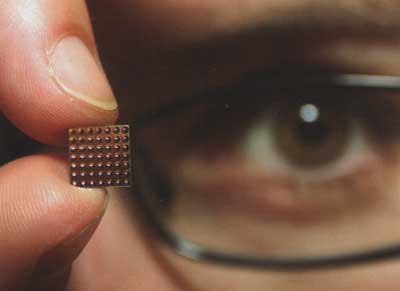| 2006 |

|
YEAR BOOK |
Tyndall National Institute
|
Tyndall National Institute
|

Tyndall National Institute in Cork is Ireland's largest research institute, undertaking research and development and fourth-level education in Information and Communications Technology (ICT). It was established in 2004 to bringing together research in ICT within the National Microelectronics Research Centre, University College Cork (UCC) and Cork Institute of Technology. This established a critical mass of over 300 researchers and includes 17 SPI-funded Principal Investigators (Pis). In January 2006, Prof Roger Whatmore was appointed CEO and Tyndall was established as a "stand-alone" entity with its own Board of Directors (subject to the financial and legal precepts of UCC) by a Memorandum of Understanding signed by the President of University College Cork, Professor Gerry Wrixon and the Minister for Enterprise, Trade and Employment, Mr Micheal Martin TD.
Informed by the future needs of Irish industry and by the Irish Government's Strategy for Science, Technology and Innovation (STI) 2006 - 2013, Tyndall's vision is to play a central role in the future development of Ireland's knowledge economy. This will be achieved through world-class teams performing ground- breaking research on new materials, devices and systems and focusing on delivering value from this research to the Irish economy. The success of this vision will be a key element in the future economic development of Ireland through the attraction of inward-investment from high technology multinational companies, the encouragement of existing indigenous companies to increasingly embed their R&D in the country, and the generation of new businesses through high potential start-up companies.
In mid 2006, the Tyndall Board approved a 5-year Strategic Plan which will see Tyndall substantially grow its activity through a combination of government, EU and contract- funded research, together with a strong level of commercial development work for industry partners. Over the period 2006 to 2011, this growth will help increase the numbers of staff and students from 300 to 500, resulting from an increase in leading-edge research teams, a doubling of PhD graduates and the location of industry suites and incubation facilities within the expanded Tyndall facility.
Tyndall's research programmes
Tyndall's research activities are focussed into three, strongly inter-related technical areas, identified as critical for Ireland's future, vis: Micro/Nanoelectronics, Microsystems and Photonics. The drive is towards the development of systems based upon leading research in materials (especially nanomaterials), electronic devices, circuits and advanced packaging/sub-systems integration. It is supported by strong activities in theory, modelling and design. The following highlights some of the key activities within the Institute:
� Tyndall's high-quality Central Fabrication Facility (CPF) for materials and devices based on silicon III-V semiconductors and polymer, offer significant flexibility and are extensively used in the integration of novel materials, structures and devices on standard CMOS and III-V platforms. This functional integration of devices, such as RF MEMS switches, passives, energy sources, sensors and magnetic materials, is augmenting the performance of traditional CMOS and extending its reach into many new application domains, including medical devices, environ-mental monitoring, automotive components and the broad, emerging area of system-on-a-chip devices.
� Engineers at Tyndall are researching the use of new concepts in low cost, intelligent sensors, employing wireless sensor network technologies to facilitate their widespread deployment throughout the environment. This will drive a move away from our present computer/information-centric world to a more person-centric approach, referred to as "Ambient Intelligence" or "Smart Environments". This team is developing miniaturised, 3-D autonomous, wireless sensor modules, with dimensions from 25mm down to the ultimate 1mm "intelligent seed". New concepts include the deployment of on-chip power supplies, designed to extract power from the ambient environment. We are already seeing their applications in fields as diverse as heaithcare, energy efficient building management, agriculture and water- based environmental research.

� The availability, in Tyndall, of advanced micro and nano technology (MNT) fabrication and integration facilities allows the development of microsystems that bring the benefits of miniaturization, precision, parallelism, and added functionality to medical and biological applications. Future applications being researched include electronic-neural implants, lab-on-chip, point-of-care DNA diagnostics and silicon microneedle arrays for pain-free drug delivery and targeted therapeutics.

� Theoretical researchers at Tyndall are playing a major role in exploring the future limits of semiconductor devices, by understanding the quantum effects to describe current flow through individual molecules, by predicting and analysing the benefits and drawbacks of new material combinations such as high-K dielectrics on silicon, and also by exploring materials which may shift paradigms, such as silicon nanowires and spintronics based on C60 molecules.
Industry partnerships and research collaborations
Tyndall is playing an important role in supporting Irish industry, covering all levels of activity from large multi-national companies to newly founded start-ups. It is doing this through one-to-one interactions, through industry networks (such as MIDAS (Microelectronic Industry Design Association)), PEIG (Power Electronics Industry Group) and WiSEN (Wireless Sensor Networks)) and through academic-industry collaborations such as the Centre for Telecommunications Value-Chain Research (CTVR) and the Biomedical Diagnostics Institute (BDI) - both funded under the SFI programme for "Centres for Science and Engineering Technology (CSET)"
Tyndall infrastructure developments
Tyndall is currently embarking upon a construction/development programme designed to deliver the space required to undertake the expansion of research objectives and staff numbers outlined above. This is designed to deliver ca 2,400m 2 of combined office and electronics test laboratories and a new laboratory building with 3,500m 2 of space for fabrication, chemistry, materials, photonics and electronics research. Together, these will roughly double the available floor-space in Tyndall.
Conclusion
The realisation of the vision for Tyndall will see it develop as a world-leading research institute in which the achievement of excellence is seen as a route to delivering value for the Irish economy. It will lead to new technical capabilities, based around the focusing of effort to deliver ICT material devices, sub-systems and systems with high intellectual added-value. The vision will see Tyndall playing a major role in the education and training of human capital at post-graduate level for the Irish economy and playing a full role in the delivery of the government's Strategy for Science Technology and Innovation (STI) 2006-2013.
Contact: Professor Roger W. Whatmore
CEO, Tyndall National Institute,
Lee Maltings, Prospect Row,Cork.
Tel: 021 4904171
